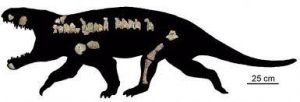Bharitalasuchus Tapani.:

In the mid 20th century, researchers from the Indian Statistical Institute, Kolkata, carried out extensive studies on rocks of the Yerrapalli Formation in what is now Telangana, uncovering several fossils.
- By studying some of these specimens stored at the Institute, an international team has now thrown light on a carnivorous reptile that lived 240 million years ago.
- They named it Bharitalasuchus Tapani.
- In the Telugu language, Bhari means huge, Tala means head, and Suchus is the name of the Egyptian crocodile-headed deity.
- The species is named after paleontologist Tapan Roy Chowdhury in honor of his extensive work on the Yerrapalli Formation tetrapod fauna.
- This reptile belonged to a family of extinct reptiles named Erythrosuchidae.
- Bharitalasuchus Tapani were robust animals with big heads and large teeth, and these probably predated other smaller reptiles. They were approximately the size of an adult male lion and might have been the largest predators in their ecosystems.
- The Yerrapalli Formation is a Triassic rock formation consisting primarily of mudstones that outcrops in the Pranhita–Godavari Basin in Telangana.




